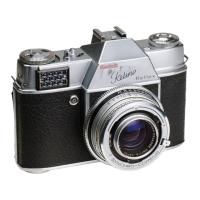The N2 supplementary lens is used. The legs are used fully extended with the lens set to infinity, and fully
pushed in (a different baseplate is used) with the lens set to the nearest distance. A special lighting unit
consisting of two adjustable lamp reflectors with arms fixing to the camera holder is available as an extra
THE CLOSE-UP STAND
The table stand is used with the Retina Reflex Iii and S
models for close-ups in natural size. To assemble the
stand, the main collar (2) with the legs fits into the
camera (1) in place of the lens (3). The latter. with an
R1:2 close-up lens (4) and the lens hood (5), goes into
the extension collar. The base plate (6), extended to
the ends of the legs, acts as a distance gauge and
outlines the field taken in.
In use, the close-up stand with the camera is simply
placed on top of the subject to be copied. The plane of
sharpest focus is the underside of the base plate.
For copying colour slides on black-and-white film, a
slide holder attachment screws into the bottom of the
base plate (lower left) and holds the slide in position.
The diffusing screen belonging to the slide holder
illuminates the transparency from behind when pointed
at a suitable light source.
FINDER ACCESSORIES
The right-angle finder attachment (left) fits over the
eyepiece of the Retina Reflex and Reflex S Models (a
special adaptor is required for the Reflex III) for a
waist-level view of the image (e.g., when shooting
round corners) or for a horizontal view when the
camera Is pointing downwards.
The frame finder model S (right) is useful for sports
photography. Swing-in frames outline the reduced field
of view 85 mm. and 135 mm. lenses.
The 1:1 Close-up Stand
This permits same-size reproductions with the Retina Reflex III and S with f2.8 lens. It is used in conjunction
with the R1:2 close-up lens. This stand permits easy reproduction of things like postage stamps, jewellery, small
mechanical parts, etc., of little thickness. It will also be found useful for copying colour transparencies. For this
purpose a slide holder with diffusing screen is available.
The stand consists of a baseplate with a 24x36 mm. opening, and an extension tube ring with legs. The latter
hold the camera system at the right distance from the subject plane.
To set up the stand, loosen the black thumb-screw connecting the baseplate to the body. Move the baseplate
until the ends of the legs are flush with the baseplate. Tighten the thumb-screw again.
Attach the stand to the camera in place of the lens. Screw the R1:2 lens into camera lens and clip on the lens
hood. Mount the camera lens on table stand. Place the camera with the table stand on top of the subject. Stop
down to f22 to obtain maximum depth of field. A slide holder with diffusing screen can be screwed to the
baseplate to hold colour transparencies in a spring clip.
The Micro-Adaptor
For making photographic records in black-and-white or colour of microscope investigations, the Retina Reflex
micro-adaptor is useful and simple to handle.
The micro-adaptor allows the Retina Reflex camera (but not with f1.9 Xenon or Heligon) to be used with any
microscope with a standard eyepiece diameter of 25 mm. The attachment consists of a light metal body with a
focusing eyepiece at the front and an arm to hold the camera at the back.

